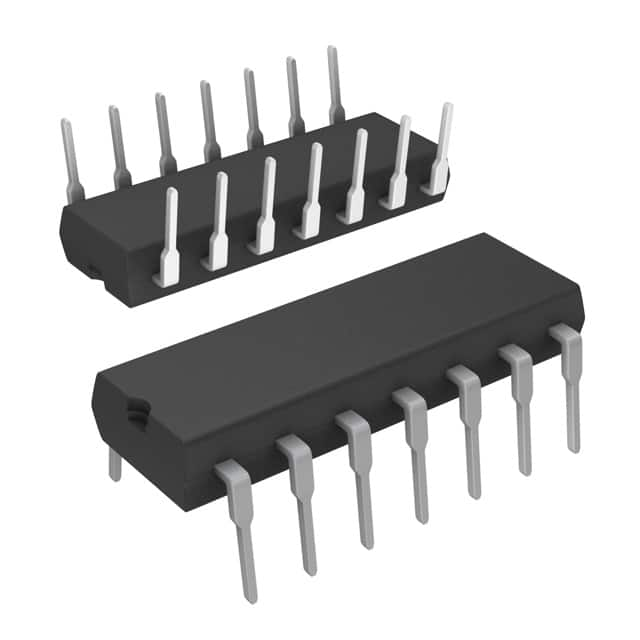Xem thông số kỹ thuật để biết chi tiết sản phẩm.

KA319
Product Overview
Category: Integrated Circuit (IC)
Use: The KA319 is a versatile operational amplifier designed for various applications in electronic circuits. It can be used as a voltage follower, inverting amplifier, non-inverting amplifier, and more.
Characteristics: - High gain and bandwidth - Low input offset voltage - Low input bias current - Wide supply voltage range - Stable operation over a wide temperature range
Package: The KA319 is available in a standard 8-pin dual in-line package (DIP) or surface mount package (SMD).
Essence: The KA319 is an essential component in analog circuit design, providing amplification and signal conditioning capabilities.
Packaging/Quantity: The KA319 is typically sold in reels or tubes containing multiple units, with quantities varying depending on the supplier.
Specifications
- Supply Voltage Range: ±2V to ±18V
- Input Offset Voltage: 1mV (maximum)
- Input Bias Current: 30nA (maximum)
- Gain Bandwidth Product: 1MHz (typical)
- Slew Rate: 0.5V/µs (typical)
- Common Mode Rejection Ratio: 70dB (typical)
- Operating Temperature Range: -40°C to +85°C
Pin Configuration
The KA319 has eight pins arranged as follows:
```
| | --| IN- OUT |-- Pin 1: Inverting Input (-) --| IN+ VCC |-- Pin 2: Non-Inverting Input (+) --| VEE NC |-- Pin 3: Negative Power Supply --| OUT IN+ |-- Pin 4: Output --| NC IN- |-- Pin 5: Non-Connected --| NC VEE |-- Pin 6: Non-Connected --| NC NC |-- Pin 7: Non-Connected --| NC VCC |-- Pin 8: Positive Power Supply |___________| ```
Functional Features
The KA319 offers the following functional features:
High Gain: The amplifier provides a high voltage gain, allowing for precise amplification of weak signals.
Low Input Offset Voltage: The low input offset voltage ensures minimal error in signal amplification.
Low Input Bias Current: With low input bias current, the KA319 minimizes the impact on the input signal source.
Wide Supply Voltage Range: The operational amplifier can operate with a wide range of supply voltages, providing flexibility in various circuit designs.
Stable Operation: The KA319 maintains stable operation over a wide temperature range, making it suitable for diverse environmental conditions.
Advantages and Disadvantages
Advantages: - Versatile functionality for different circuit applications - High gain and bandwidth - Low input offset voltage and bias current - Wide supply voltage range - Stable operation over a wide temperature range
Disadvantages: - Limited output current capability - Higher power consumption compared to some modern operational amplifiers
Working Principles
The KA319 is based on the principles of operational amplifiers. It utilizes differential input stages, gain stages, and output stages to amplify and condition input signals. The internal circuitry ensures accurate amplification while minimizing errors caused by input offset voltage and bias currents.
Application Field Plans
The KA319 can be used in various applications, including but not limited to: - Audio amplifiers - Signal conditioning circuits - Active filters - Instrumentation amplifiers - Voltage regulators - Oscillators
Alternative Models
There are several alternative models available that offer similar functionality to the KA319. Some popular alternatives include: - LM741 - TL071 - NE5532 - AD823
These alternatives may have slightly different specifications and pin configurations, so it is important to consult the respective datasheets for detailed information.
In conclusion, the KA319 is a versatile operational amplifier that provides high gain, low offset voltage, and stable operation. Its wide range of applications makes it a valuable component in various electronic circuits.
Liệt kê 10 câu hỏi và câu trả lời thường gặp liên quan đến ứng dụng KA319 trong giải pháp kỹ thuật
Sure! Here are 10 common questions and answers related to the application of KA319 in technical solutions:
Q: What is KA319? A: KA319 is a type of integrated circuit (IC) commonly used in technical solutions for various applications.
Q: What are the main features of KA319? A: The main features of KA319 include low power consumption, high gain, wide input voltage range, and compatibility with different supply voltages.
Q: In which technical solutions can KA319 be used? A: KA319 can be used in a wide range of technical solutions such as audio amplifiers, signal conditioning circuits, sensor interfaces, and voltage regulators.
Q: How does KA319 help in audio amplifier applications? A: KA319 provides high gain and low distortion characteristics, making it suitable for audio amplifier applications where accurate amplification of audio signals is required.
Q: Can KA319 be used in battery-powered devices? A: Yes, KA319's low power consumption makes it suitable for battery-powered devices where energy efficiency is crucial.
Q: Is KA319 compatible with different supply voltages? A: Yes, KA319 is designed to work with a wide range of supply voltages, typically ranging from 3V to 18V.
Q: Does KA319 have any built-in protection features? A: Yes, KA319 often includes built-in protection features such as short-circuit protection and thermal shutdown to ensure safe operation.
Q: Can KA319 be used in industrial control systems? A: Absolutely, KA319's wide input voltage range and robust design make it suitable for use in industrial control systems where reliability is essential.
Q: Are there any specific application notes or reference designs available for KA319? A: Yes, many manufacturers provide application notes and reference designs that showcase the best practices for using KA319 in various technical solutions.
Q: Where can I purchase KA319 ICs? A: KA319 ICs are commonly available from electronic component distributors, online marketplaces, and directly from semiconductor manufacturers' websites.
Please note that the specific details and answers may vary depending on the manufacturer's specifications and application requirements.

